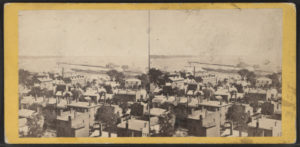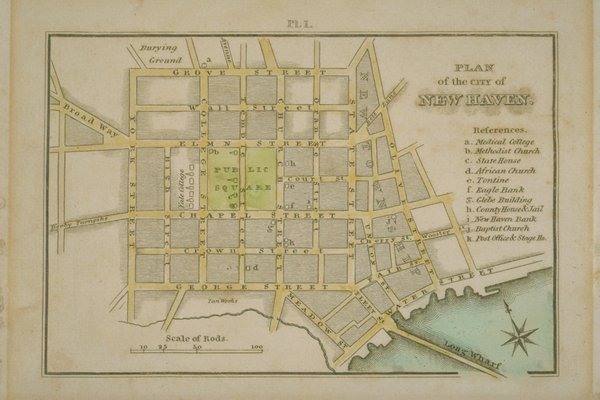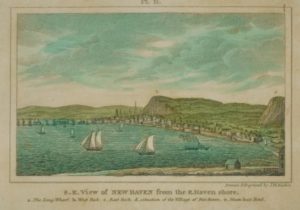By Edward T. Howe
From the 17th through the 19th centuries, the Long Wharf at New Haven was a notable part of the city’s commercial development. When completed, the timber, stone, and earthen wharf was the longest ever built in the country, intended to reach deep water beyond the sedimentation of the shallow inner harbor. Despite the Long Wharf’s prominence, however, railroad expansion and highway construction ensured the demise of the original wharf by the early 1960s.
The Long Wharf is Built in New Haven
The City of New Haven, settled by the Reverend John Davenport and Theophilus Eaton in 1638, is located in the south-central part of the state. New Haven Harbor—formed by the flowing of the Quinnipiac, Mill, and West rivers—consists of an inner and outer harbor and is located on the Long Island Sound. The outer harbor is four miles wide (with breakwaters constructed in the 19th century); but the inner harbor, where the Mill and Quinnipiac rivers meet, is shallow and less than a quarter mile wide.
Before the construction of the Long Wharf in New Haven, goods arrived in the outer harbor from England and elsewhere and were offloaded to smaller boats (“lighters”) that were sent to small wharves on tidal creeks. In 1663, Samuel Bache received the first grant to build a wharf and warehouse in the harbor. Twenty years later, Thomas Trowbridge also obtained a grant for a wharf and warehouse that adjoined the Bache grant. The two grants constituted the commencement of a wharf to reach deeper water. Officials formally named the timber wharf “Union Wharf” (incorporated in 1760) and further extended it by 1731. By 1738, however, it was popularly called Long Wharf and extended 429 feet into the harbor. In 1770, the Union Wharf Company built an 80-foot square “pier”, or platform, next to a deep-water channel. The pier permitted large ships to discharge their cargo, which smaller vessels then carried to Long Wharf, a third of a mile away.
The Long Wharf and its Importance to Trade
During the Colonial era, New Haven merchants chiefly engaged in trading with coastal and West Indies ports. Small sloops carried agricultural products, livestock, and lumber primarily to New York and Boston. The sloops returned to New Haven with English manufactured goods such as woolen textiles, gunpowder, and hats. Merchants also exported large amounts of the same non-manufactured goods to the West Indies, primarily Barbados and St.Kitts, in exchange for sugar, molasses, rum, and, quite often, enslaved people.
The American Revolution interrupted trade in New Haven, but after the Treaty of Paris in 1783 officially ended the war, New Haven quickly resumed its trade activity. A year later, a small area of the larger rural town incorporated as the City of New Haven, giving it more power to determine its commercial and political interests.
In 1810, the owners of Long Wharf finally began building a needed 1,350-foot stone and earth-filled expansion of the wharf to the pier under the direction of William Lanson—a prominent Black business owner. When it was completed in 1811, the wharf was 3,480 feet long—the longest ever built in the United States. New Haven built even more offices, warehouses, stores, and other commercial buildings on the extension. In October 1820, a large fire almost destroyed the entire wharf. After workers rebuilt Long Wharf, they added a 105-foot extension—completed in 1822.
The Railroad and the Demise of the Long Wharf

Harbor and Long Wharf, from Depot Tower, New Haven by Whitney, Beckwith & Paradice – Wikimedia Commons
Meanwhile, the Farmington Canal Company, also incorporated in 1822 (as a private waterway), attempted to gain access to the products of the upper reaches of the Connecticut Valley and bring them to New Haven. As part of this venture, the canal company built Basin Wharf at a diagonal to Long Wharf. This addition enclosed Union Basin—which was located at the southern terminus of the canal—where canal boats delivered and assumed cargo.
Two years later, The New Haven and Northampton Railroad, chartered in 1846, forced the unprofitable Farmington Canal to shut down and converted the property into a rail line. By 1852, the railroad obtained the right to fill in Union Basin for its facilities. Less than two decades later, by 1870, Union Basin was fully enclosed and the railroad had built the Canal Wharf, a competing wharf parallel to Long Wharf. Both Canal Wharf and another wharf, Belle Dock, offered more efficient connections to the railroad. Long Wharf merchants adapted to these encroachments in the late 19th century by focusing on meatpacking, certain storage facilities, management of West Indies trading, and domestic imports of bulk commodities—coal, lumber, and iron. In 1890, the owners sold the entire wharf to the New York, New Haven and Hartford Railroad for $100,000 to help it handle its freight activity. The end of the wharf’s independent identity only magnified its loss of importance.
By the mid-1960s, the original Long Wharf had largely disappeared due to railroad and industrial usage, fill-in activity from construction of the Connecticut Turnpike (I-95), and development of a new Long Wharf above the ruins of the old structure. Nevertheless, for about two centuries—before railroad service—the economic prosperity of New Haven significantly depended upon Long Wharf.
Edward T. Howe, Ph.D., is Professor of Economics, Emeritus, at Siena College near Albany, N.Y.










